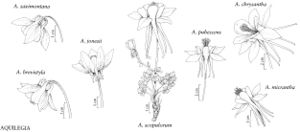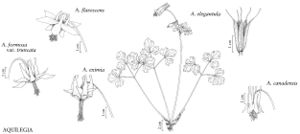Aquilegia
Sp. Pl. 1: 533. 175.
Gen. Pl. ed. 5, 237. 1754.
Herbs, perennial, from slender woody rhizomes. Leaves basal and cauline, proximal leaves petiolate, distal leaves sessile; cauline leaves alternate. Leaf-blade 1-3×-ternately compound, leaflets lobed or parted, margins crenate. Inflorescences terminal, 1-10-flowered cymes or solitary flowers, to 30 cm; bracts leaflike, not forming involucre. Flowers bisexual, radially symmetric; sepals not persistent in fruit, 5, white to blue, yellow, or red, plane, narrowly ovate to oblong-lanceolate, short-clawed, 7-51 mm; petals 5, distinct, white to blue, yellow, or red, oblong to rounded or spatulate blade, 0-30 mm, base backward-pointing tubular spur, apex plane; nectary in ± enlarged tip of spur; stamens many; filaments filiform; scalelike staminodes usually present between stamens and pistils; pistils 5-10, simple; ovules many per pistil; beak present. Fruits follicles, aggregate, sessile, cylindric, sides prominently veined; beak terminal, straight, 3-26 mm. Seeds black, obovoid, smooth. x = 7.
Distribution
Circumboreal
Discussion
Species ca. 70 (21 in the flora).
Species of Aquilegia are polymorphic and difficult to define adequately. Some of the variability is because of introgressive hybridization. Even distantly related species of columbine are often freely interfertile, and many cases of natural hybridization and introgression are known from North America. Only the most important are mentioned below. In arid areas Aquilegia species tend to form small populations often completely isolated from one another. This leads to local fixation of genes and therefore increased variability in species such as A. micrantha and A. desertorum. In addition, populations with spurless petals are occasionally found in many species.
Selected References
None.
Lower Taxa
Key
| 1 | Spurs hooked, 3-22 mm; sepals white or blue. | > 2 |
| 1 | Spurs straight or nearly so (sometimes tips incurved in A. flavescens), 8-180 mm; sepals blue, white, cream, yellow, pink, or red (A. flavescens with yellow or pink sepals). | > 5 |
| 2 | Spurs 14-22 mm; introduced species, at low elevations (0-1500 m). | Aquilegia vulgaris |
| 2 | Spurs 3-10 mm; native, at high elevations or high latitudes. | > 3 |
| 3 | Basal leaves much shorter than stems. | Aquilegia brevistyla |
| 3 | Basal leaves about as long as stems. | > 4 |
| 4 | Sepals and spurs white or nearly so; Wyoming. | Aquilegia laramiensis |
| 4 | Sepals and spurs blue; Colorado. | Aquilegia saximontana |
| 5 | Sepals and spurs blue, white, cream, reddish purple, or occasionally pink (if pink then with no trace of yellow); flowers usually erect (sometimes nodding in A. micrantha); spurs slender (stout at least proximally in A. jonesii), evenly tapered from base. | > 6 |
| 5 | Sepals and spurs yellow, pink and yellow, or red; flowers erect or nodding; spur shape various. | > 9 |
| 6 | Leaflets viscid. | Aquilegia micrantha |
| 6 | Leaflets not viscid. | > 7 |
| 7 | Spurs 8-15 mm. | Aquilegia jonesii |
| 7 | Spurs 25-70(-72) mm. | > 8 |
| 8 | Leaflets glaucous on both sides, 5-14 mm, crowded (primary petiolules 3-15 mm); spurs 25-40 mm. | Aquilegia scopulorum |
| 8 | Leaflets green adaxially, 13-42(-61) mm, not crowded, primary petiolules (10-)20-70 mm; spurs 28-72 mm. | Aquilegia coerulea |
| 9 | Sepals red (at least proximally); spurs red (red proximally, then pink in A. shockleyi), stout (at least proximally), abruptly narrowed near middle, 12-32 mm; flowers nodding or pendent. | > 10 |
| 9 | Sepals and spurs yellow or pink; spurs slender (except for A. flavescens and A. barnebyi), evenly tapered from base (sometimes abruptly narrowed near middle in A. flavescens and A. micrantha), 10-180 mm; flowers usually erect, sometimes nodding. | > 15 |
| 10 | Sepals perpendicular to floral axis; petal blades 0-6 mm. | > 11 |
| 10 | Sepals parallel to or divergent from floral axis; petal blades 4-12 mm. | > 13 |
| 11 | Mouth of spur cut obliquely backward; stamens 17-30 mm. | Aquilegia eximia |
| 11 | Mouth of spur truncate or with short blade; stamens 12-17 mm. | > 12 |
| 12 | Leaflets glaucous on both sides; petal blades 2-5 mm. | Aquilegia shockleyi |
| 12 | Leaflets green adaxially; petal blades 0-6 mm. | Aquilegia formosa |
| 13 | Sepals red proximally, yellow-green distally, not much longer than petal blades; stamens 8-14 mm. | Aquilegia elegantula |
| 13 | Sepals red or apex green or yellow-green, about 2 times length of petal blades; stamens 14-23 mm. | > 14 |
| 14 | Blades of petals pale yellow or yellow-green; basal leaves 2×-ternately compound, leaflets to 17-52 mm; e North America, w to c Texas. | Aquilegia canadensis |
| 14 | Blades of petals yellow or red and yellow; basal leaves 2-3×-ternately compound, leaflets to 9-26(-32) mm; Arizona, New Mexico, Utah. | Aquilegia desertorum |
| 15 | Spurs 42-180 mm. | > 16 |
| 15 | Spurs 10-40 mm. | > 18 |
| 16 | Spurs 72-180 mm; petal blades spatulate. | Aquilegia longissima |
| 16 | Spurs 42-70 mm; petal blades oblong, not much broadened distally. | > 17 |
| 17 | Sepals 14-18 mm wide. | Aquilegia hinckleyana |
| 17 | Sepals 5-10 mm wide. | Aquilegia chrysantha |
| 18 | Spurs yellow, stout, ± incurved, 10-18 mm; flowers nodding. | Aquilegia flavescens |
| 18 | Spurs yellow to pink or cream, slender, straight, 15-40 mm; flowers erect to nodding. | > 19 |
| 19 | Beak 15-18 mm; sepals 9-19 mm, yellow; se New Mexico, w Texas. | Aquilegia chaplinei |
| 19 | Beak 8-12 mm; sepals not as above: either cream or pink or if yellow, then (15-)20-25 mm; Colorado, Arizona to California. | > 20 |
| 20 | Sepals (15-)20-25 mm, petal blades 8-17 mm, spurs 25-40 mm; flowers erect; California. | Aquilegia pubescens |
| 20 | Sepals 8-20 mm, petal blades 6-10 mm, spurs 14-30 mm; flowers nodding or erect; Colorado, Arizona, Utah. | > 21 |
| 21 | Leaflets viscid, green adaxially. | Aquilegia micrantha |
| 21 | Leaflets not viscid, glaucous on both surfaces. | Aquilegia barnebyi |

